Hydrogen Diffusion in Nickel Superalloys: Electrochemical Permeation Study and Computational AI Predictive Modeling
Abstract
:1. Introduction
2. Materials and Methods
2.1. Thermodynamic Study of the Phases in Ni-Cr-Fe-C Alloys
2.2. Material Acquisition, Manufacturing, and Characterization
- Average grain size (AGS, μm): Measurements of at least 50 grains applying the irregular polygons method. The evaluated area was ≈1 mm2 (up to 4 mm2 in microstructures with grain size greater than 150 μm).
- Average precipitate size (APS, μm) and precipitate fraction (PA/TA): The apparent precipitates were measured. The area analyzed for each sample was 4.3 mm2, and the number of measurements, as a function of the image quality, ranged from 150 to ≈3000 per sample, considering a roundness criterion > 0.5.
2.3. Hydrogen Permeation Tests
2.4. AI Predictive Model
- Database: The database was set up from the results of elemental chemical characterizations, microstructural measurements, and the permeability test results. Furthermore, the results acquired and reported in previous work [5] were used to build the database. The resulting database was normalized from 0 to 1 and from −1 to 1; later, the sigmoid and hyperbolic functions, Equations (6) and (7), were implemented as transfer functions in the ANN neurons.
- Training process: Forty neural networks were trained, composed of one hidden layer and a linear transfer function at the output layer; this was implemented in the whole models. In contrast, the type of normalization data, transfer functions at hidden layers, and the number of neurons were varied. The training was supervised, and the learning was assessed by comparing the predicted with the experimental results using the method of minimum square error (MSE). Moreover, the Levenberg–Marquardt algorithm was also implemented for neural network learning; this has been widely used in this type of AI application [41,42,43]. On the other hand, the data for the training process were divided as follows: 70% for training, 15% for first validation, and 15% for final test. The last mentioned 15% was not part of the original code; this was performed to assess the predictive capability and verify the learning performance. The input and output variables of the predictive models used in the described processes are shown in Table 2.
3. Results
3.1. X-ray Diffraction
3.2. Metallography
3.3. Permeation Tests
3.4. Predictive Model
4. Discussion
4.1. Impact Parameters on the H Diffusivity in Ni-Based Alloys
- High fΣ fraction microstructure: It is necessary to consider that the H trapping could be higher in alloys composed of Σ3n and Σ1 grain boundaries. This can be a valuable strategy to avoid H diffusion from the surface and subsurface. However, it would not be possible to avoid it entirely. Consequently, the H would be trapped, triggering some HE mechanism.
- Percolated microstructure: For this case, the literature reports show high H diffusivity since the effect of high-angle grain boundaries and random connectivity at triple junctions considerably accelerate the absorption and diffusion. A percolated microstructure would present greater Deff values, similar to the present work. This percolated effect intends to exhibit a superimposing effect on irreversible traps, even though these traps are preferably formed at high-angle grain boundaries and high-energy triple junctions.
4.2. Future Considerations in Predictive Modeling Using AI
5. Conclusions
- The increment in the Cr content from 10 to 28% does not cause significant changes in the FCC lattice’s interatomic spacing. The lattice parameters calculated for experimental superalloys are in agreement with literature reports of In 600 and In 690.
- The grain size of the 28Cr alloy differs from the rest of the obtained measurements; nevertheless, based on the permeability results, this difference does not seem to have significant influence on the H diffusivity.
- The 10Cr, 28Cr, and In 690 alloys present a trapping effect, reflected in the Deff results, and exhibit an H accumulation; a discrete decrease in the Jss values validates the latter phenomenon. Regarding the commercial alloys, In 690 exhibits a minimum change in the Jss values between transients. The alloy In 600 showed the highest Jss, a behavior that the authors have previously reported. Finally, an increase in Deff and a decrease in Jss were observed for the 15Cr alloy, related to the transients; this effect is possibly generated by reversible trapping, which results in H accumulation.
- From Figure 8, the first transient suggests insignificant H trapping, except for the In 600 Au/Pd alloy.
- An alternative method for NL calculations was proposed, having an approach similar to previous models.
- It was possible to develop predictive models to calculate Deff and Jss based on 10 input variables. The correlation coefficients showed the excellent performance of this AI-based method. The modeling using artificial neural networks can be improved, including additional parameters such as grain boundary misorientation, thermal desorption spectroscopy assessments, and heat treatment application.
- The relative importance calculation presented interesting insights related to the observations and the interpretations of the different results. In general, the transient effect, the elemental content of Ni and Cr, and the Au/Pd coating were the main impact variables on the diffusivity and permeability of H.
Author Contributions
Funding
Acknowledgments
Conflicts of Interest
References
- Liu, L.; Zhang, J.; Ai, C. Nickel-based superalloys. Encycl. Mater. Met. Alloy 2020, 1, 294–304. [Google Scholar] [CrossRef]
- Nguyen, Q.B.; Nai, M.L.S.; Zhu, Z.; Sun, C.-N.; Wei, J.; Zhou, W. Characteristics of Inconel Powders for Powder Bed Additive Manufacturing. Engineering 2017, 3, 695–700. [Google Scholar] [CrossRef]
- Sui, S.; Li, H.; Li, Z.; Zhao, X.; Ma, L.; Chen, J. Introduction of a New Method for Regulating Laves Phases in Inconel 718 Superalloy during a Laser-Repairing Process. Engineering 2022, 16, 239–246. [Google Scholar] [CrossRef]
- Hurley, C.; Martin, F.; Marchetti, L.; Chêne, J.; Blanc, C.; Andrieu, E. Role of grain boundaries in the diffusion of hydrogen in nickel base alloy 600: Study coupling thermal desorption mass spectroscopy with numerical simulation. Int. J. Hydrogen Energy 2016, 41, 17145–17153. [Google Scholar] [CrossRef]
- Monzamodeth, R.; Campillo, B.; Flores, O. Hydrogen diffusion in Ni-Cr-Fe system. Mater. Today Proc. 2021, 42, 1170–1175. [Google Scholar] [CrossRef]
- Li, X.; Zhang, J.; Akiyama, E.; Fu, Q.; Li, Q. Hydrogen embrittlement behavior of Inconel 718 alloy at room temperature. J. Mater. Sci. Tech. 2019, 35, 499–502. [Google Scholar] [CrossRef]
- Fischer, F.; Mori, G.; Svoboda, J. Modelling the influence of trapping on hydrogen permeation in metals. Corros. Sci. 2013, 76, 382–389. [Google Scholar] [CrossRef]
- Tehranchi, A.; Zhou, X.; Curtin, W. Curtin. A decohesion pathway for hydrogen embrittlement in nickel: Mechanism and quantitative prediction. Acta Mater. 2020, 185, 98–109. [Google Scholar] [CrossRef]
- Alvaro, A.; Jensen, I.T.; Kheradmand, N.; Løvvik, O.; Olden, V. Hydrogen embrittlement in nickel, visited by first principles modeling, cohesive zone simulation and nanomechanical testing. Int. J. Hydrogen Energy 2015, 40, 16892–16900. [Google Scholar] [CrossRef]
- Torres, E.; Pencer, J.; Radford, D. Atomistic simulation study of the hydrogen diffusion in nickel. Comput. Mater. Sci. 2018, 152, 374–380. [Google Scholar] [CrossRef]
- Tehranchi, A.; Curtin, W. Atomistic study of hydrogen embrittlement of grain boundaries in nickel: I. Fracture. J. Mech. Phys. Solids 2017, 101, 150–165. [Google Scholar] [CrossRef]
- Chen, W.-J.; Gao, P.-F.; Wang, S.; Lu, H.-Z.; Zhao, Z.-Z. Effect of vanadium on hydrogen embrittlement susceptibility of high-strength hot-stamped steel. J. Iron Steel Res. 2021, 28, 211–222. [Google Scholar] [CrossRef]
- Husby, H.; Iannuzzi, M.; Johnsen, R.; Kappes, M.; Barnoush, A. Effect of nickel on hydrogen permeation in ferritic/pearlitic low alloy steels. Int. J. Hydrogen Energy 2018, 43, 3845–3861. [Google Scholar] [CrossRef]
- Akiyama, E.; Li, S. Electrochemical hydrogen permeation tests under galvanostatic hydrogen charging conditions conventionally used for hydrogen embrittlement study. Corros. Rev. 2016, 34, 103–111. [Google Scholar] [CrossRef]
- Fallahmohammadi, E.; Bolzoni, F.; Lazzari, L. Measurement of lattice and apparent diffusion coefficient of hydrogen in X65 and F22 pipeline steels. Int. J. Hydrogen Energy 2013, 38, 2531–2543. [Google Scholar] [CrossRef]
- Turnbull, A. Perspectives on hydrogen uptake, diffusion and trapping. Int. J. Hydrogen Energy 2015, 40, 16961–16970. [Google Scholar] [CrossRef]
- Kanayama, H.; Ndong-Mefane, S.; Ogino, M.; Miresmaeili, R. Reconsideration of the hydrogen diffusion model using the McNabb-foster formulation. Mem. Fac. Eng. Kyushu Univ. 2009, 69, 149–161. [Google Scholar]
- Sofronis, P.; Robertson, I.M. Transmission electron microscopy observations and micromechanical/continuum models for the effect of hydrogen on the mechanical behaviour of metals. Phil. Mag. A 2002, 82, 3405–3413. [Google Scholar] [CrossRef]
- Turnbull, A.; Ballinger, R.G.; Hwang, I.S.; Morra, M.M.; Psaila-Dombrowski, M.; Gates, R.M. Hydrogen transport in nickel-base alloys. Metall. Mater. Trans. A 1992, 23, 3231–3244. [Google Scholar] [CrossRef]
- Turnbull, A.; Hutchings, R. Analysis of hydrogen atom transport in a two-phase alloy. Mater. Sci. Eng. A 1994, 177, 161–171. [Google Scholar] [CrossRef]
- Xu, J.; Sun, X.; Chen, W.; Li, Y. Hydrogen permeation and diffusion in iron-base superalloys. Acta Metall. Mater. 1993, 41, 1455–1459. [Google Scholar] [CrossRef]
- Sofronis, P.; McMeeking, R. Numerical analysis of hydrogen transport near a blunting crack tip. J. Mech. Phys. Solids 1989, 37, 317–350. [Google Scholar] [CrossRef]
- Oriani, R.A. The diffusion and trapping of hydrogen in steel. Acta Metall. 1970, 18, 147–157. [Google Scholar] [CrossRef]
- McNabb, A.; Foster, P.K. A new analysis of the diffusion of hydrogen in iron and ferritic steels. Trans. Metall. Soc. 1963, 227, 618–627. [Google Scholar]
- Barrera, O.; Tarleton, E.; Tang, H.; Cocks, A. Modelling the coupling between hydrogen diffusion and the mechanical behaviour of metals. Comput. Mater. Sci. 2016, 122, 219–228. [Google Scholar] [CrossRef]
- Aslan, O. Numerical modeling of hydrogen diffusion in metals accounting for large deformations. Int. J. Hydrogen Energy 2015, 40, 15227–15235. [Google Scholar] [CrossRef]
- Liang, X.; Zhao, G.-H.; Dodge, M.; Lee, T.; Dong, H.; Rivera-Díaz-Del-Castillo, P. Hydrogen embrittlement in super duplex stainless steels. Materialia 2020, 9, 100524. [Google Scholar] [CrossRef]
- Dwivedi, S.K.; Vishwakarma, M. Hydrogen embrittlement in different materials: A review. Int. J. Hydrogen Energy 2018, 43, 21603–21616. [Google Scholar] [CrossRef]
- Barrera, O.; Bombac, D.; Chen, Y.; Daff, T.D.; Galindo-Nava, E.; Gong, P.; Haley, D.; Horton, R.; Katzarov, I.; Kermode, J.R.; et al. Understanding and mitigating hydrogen embrittlement of steels: A review of experimental, modelling and design progress from atomistic to continuum. J. Mater. Sci. 2018, 53, 6251–6290. [Google Scholar] [CrossRef]
- Díaz, A.; Alegre, J.; Cuesta, I. A review on diffusion modelling in hydrogen related failures of metals. Eng. Fail. Anal. 2016, 66, 577–595. [Google Scholar] [CrossRef]
- ISO 17081:2014; Method of Measurement of Hydrogen Permeation and Determination of Hydrogen Uptake and Transport in Metals by an Electrochemical Technique. International Organization for Standardization: Geneva, Switzerland, 2014.
- Dong, C.; Liu, Z.; Li, X.; Cheng, Y. Effects of hydrogen-charging on the susceptibility of X100 pipeline steel to hydrogen-induced cracking. Int. J. Hydrogen Energy 2009, 34, 9879–9884. [Google Scholar] [CrossRef]
- Araújo, D.; Vilar, E.; Carrasco, J.P. Palma Carrasco. A critical review of mathematical models used to determine the density of hydrogen trapping sites in steels and alloys. Int. J. Hydrogen Energy 2014, 39, 12194–12200. [Google Scholar] [CrossRef]
- Zhou, P.; Li, W.; Zhao, H.; Jin, X. Role of microstructure on electrochemical hydrogen permeation properties in advanced high strength steels. Int. J. Hydrogen Energy 2018, 4, 10905–10914. [Google Scholar] [CrossRef]
- Villalobos, J.C.; Del-Pozo, A.; Vergara-Hernández, H.J.; Vázquez-Gómez, O.; Escudero-García, C.F.; Serna, S.; Campillo, B. Hydrogen gaseous embrittlement effect over mechanical properties of an experimental X-120 microalloyed steel subjected to heat treatments and different cooling rates. Int. J. Hydrogen Energy 2022, 47, 30707–30721. [Google Scholar] [CrossRef]
- Monzamodeth, R.; Flores-Alvarez, J.; Reyes-Chaparro, I.; Castillo, F.; Campillo, B.; Flores, O. Artificial neural networks for predicting potentiodynamic tests of brass 70-30. Mater. Today Proc. 2023, 80, 1514–1518. [Google Scholar] [CrossRef]
- Yoshitake, S.; Narayan, V.; Harada, H.; Bhadeshia, H.K.D.H.; Mackay, D.J.C. Mackay. Estimation of the γ and γ’ Lattice Parameters in Nickel-base Superalloys Using Neural Network Analysis. ISIJ Int. 1998, 38, 495–502. [Google Scholar] [CrossRef]
- Liu, W.; Chen, C.; Tang, Y.; Long, Q.; Wei, S.; Zhang, G.; Mao, F.; Jiang, Q.; Zhang, T.; Liu, M. Thermodynamic evaluation and investigation of solidification microstructure in the Fe–Cr–Ni–C system. Calphad 2020, 69, 101763. [Google Scholar] [CrossRef]
- Pigrova, G.D. TCP-phases in nickel-base alloys with elevated chromium content. Met. Sci. Heat. Treat. 2005, 47, 544–551. [Google Scholar] [CrossRef]
- Jebaraj, J.J.; Morrison, D.J.; Suni, I.I. Hydrogen diffusion coefficients through Inconel 718 in different metallurgical conditions. Corros. Sci. 2014, 80, 517–522. [Google Scholar] [CrossRef]
- Lv, C.; Xing, Y.; Zhang, J.; Na, X.; Li, Y.; Liu, T.; Cao, D.; Wang, F.-Y. Levenberg–Marquardt Backpropagation Training of Multilayer Neural Networks for State Estimation of a Safety-Critical Cyber-Physical System. IEEE Trans. Ind. Inform. 2018, 14, 3436–3446. [Google Scholar] [CrossRef]
- Hagan, M.T.; Menhaj, M.B. Training feedforward networks with the Marquardt algorithm. IEEE Trans. Neural Netw. 1994, 5, 989–993. [Google Scholar] [CrossRef] [PubMed]
- Marquardt, D.W. An Algorithm for Least-Squares Estimation of Nonlinear Parameters. J. Soc. Indust Appl. Math. 1963, 11, 431–441. [Google Scholar] [CrossRef]
- Garson, G.D. Interpreting neural-network connection weights. AI Expert. 1991, 6, 46–51. [Google Scholar]
- Raju, S.; Sivasubramanian, K.; Divakar, R.; Panneerselvam, G.; Banerjee, A.; Mohandas, E.; Antony, M. Thermal expansion studies on Inconel-600® by high temperature X-ray diffraction. J. Nucl. Mater. 2004, 325, 18–25. [Google Scholar] [CrossRef]
- Leroy, C.; Czerwiec, T.; Gabet, C.; Belmonte, T.; Michel, H. Plasma assisted nitriding of Inconel 690. Surf. Coat. Technol. 2001, 141, 241–247. [Google Scholar] [CrossRef]
- Oudriss, A.; Creus, J.; Bouhattate, J.; Savall, C.; Peraudeau, B.; Feaugas, X. The diffusion and trapping of hydrogen along the grain boundaries in polycrystalline nickel. Scrpt. Mater. 2012, 66, 37–40. [Google Scholar] [CrossRef]
- Oudriss, A.; Creus, J.; Bouhattate, J.; Conforto, E.; Berziou, C.; Savall, C.; Feaugas, X. Grain size and grain-boundary effects on diffusion and trapping of hydrogen in pure nickel. Acta Mater. 2012, 60, 6814–6828. [Google Scholar] [CrossRef]
- Hillert, M. On the theory of normal and abnormal grain growth. Acta Metall. 1965, 13, 227–238. [Google Scholar] [CrossRef]
- Lu, X.; Wang, D.; Johnsen, R. Hydrogen diffusion and trapping in nickel-based alloy 625: An electrochemical permeation study. Electrochim. Acta 2022, 421, 140477. [Google Scholar] [CrossRef]
- Krom, A.H.M.; Bakker, A. Hydrogen Trapping Models in Steel. Metall. Mater. Trans. B 2000, 31, 1475–1482. [Google Scholar] [CrossRef]
- Zagal, J.; López, H.; Flores, O.; Albarran, J.; Martínez, L. Microstructural effects on the hydrogen permeation of an Inconel alloy 690. Corros. Sci. 2008, 50, 3371–3377. [Google Scholar] [CrossRef]
- DeMott, R.W.; Kernion, S.; Leff, A.C.; Taheri, M.L. Mitigation of hydrogen embrittlement in alloy custom age 625 PLUS® via grain boundary engineering. Mater. Sci. Eng. A 2021, 818, 141377. [Google Scholar] [CrossRef]
- Prithiv, T.; Bhuyan, P.; Pradhan, S.; Sarma, V.S.; Mandal, S. A critical evaluation on efficacy of recrystallization vs. strain induced boundary migration in achieving grain boundary engineered microstructure in a Ni-base superalloy. Acta Mater. 2018, 146, 187–201. [Google Scholar] [CrossRef]
- Telang, A.; Gill, A.S.; Kumar, M.; Teysseyre, S.; Qian, D.; Mannava, S.R.; Vasudevan, V.K. Iterative thermomechanical processing of alloy 600 for improved resistance to corrosion and stress corrosion cracking. Acta Mater. 2016, 113, 180–193. [Google Scholar] [CrossRef]

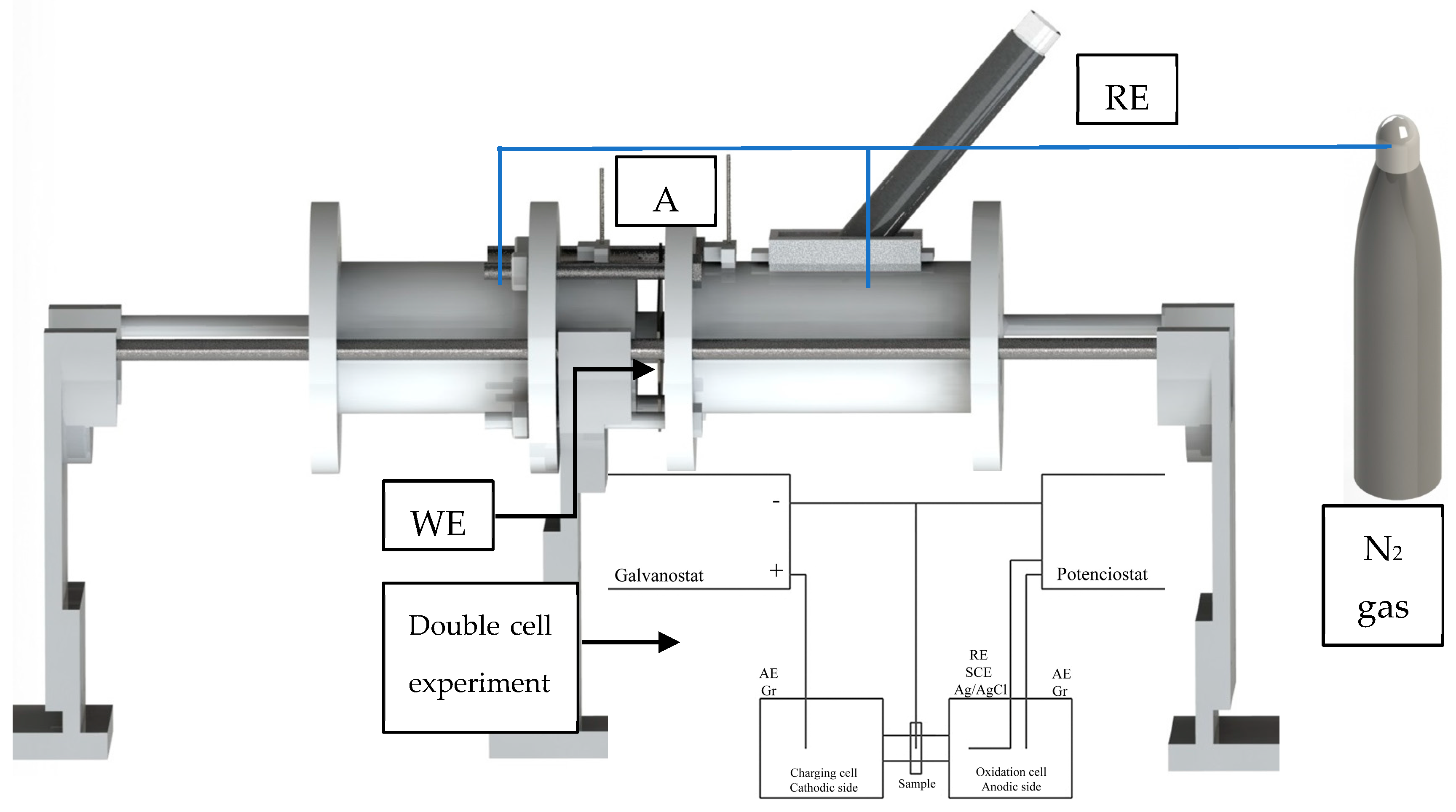
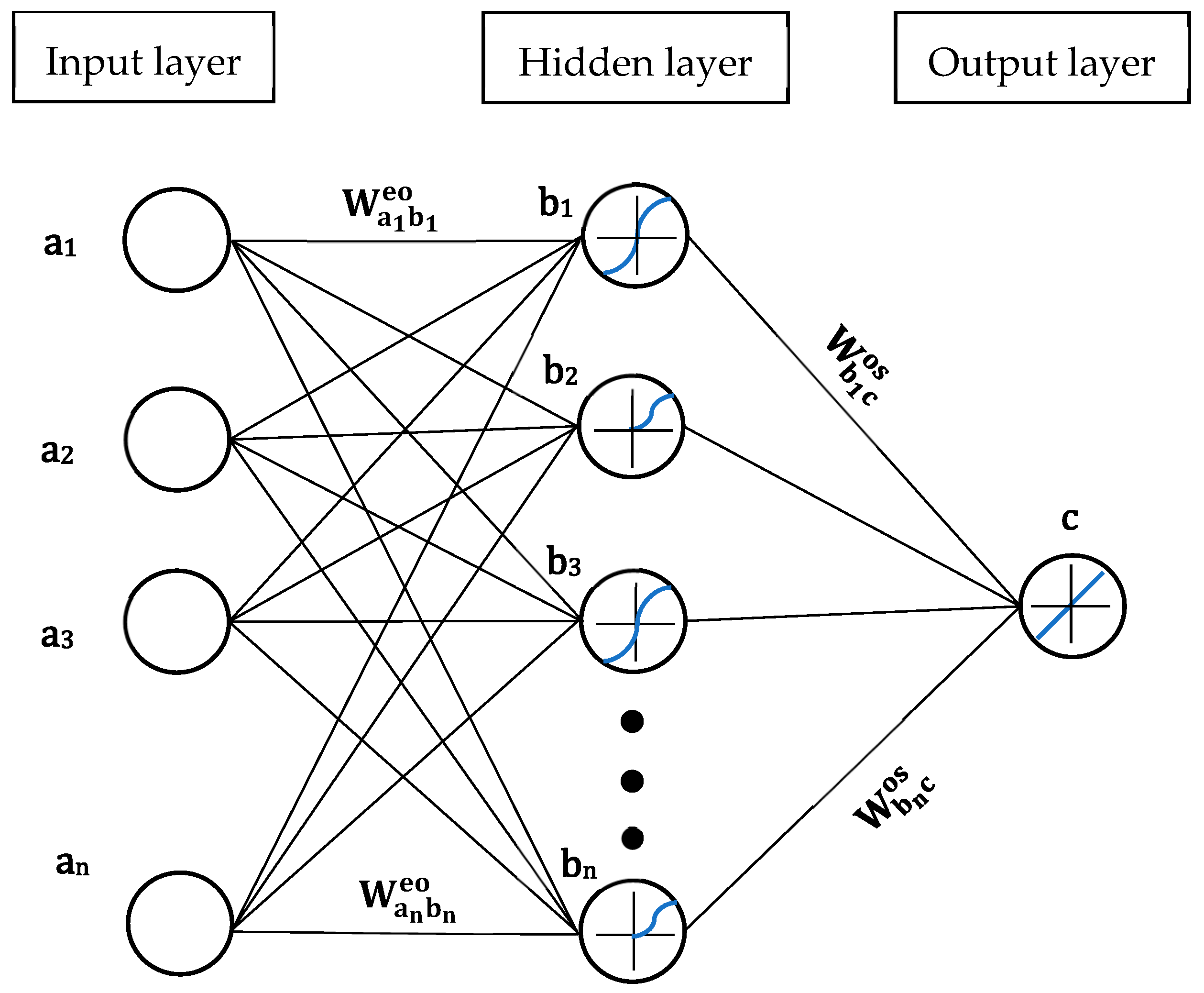
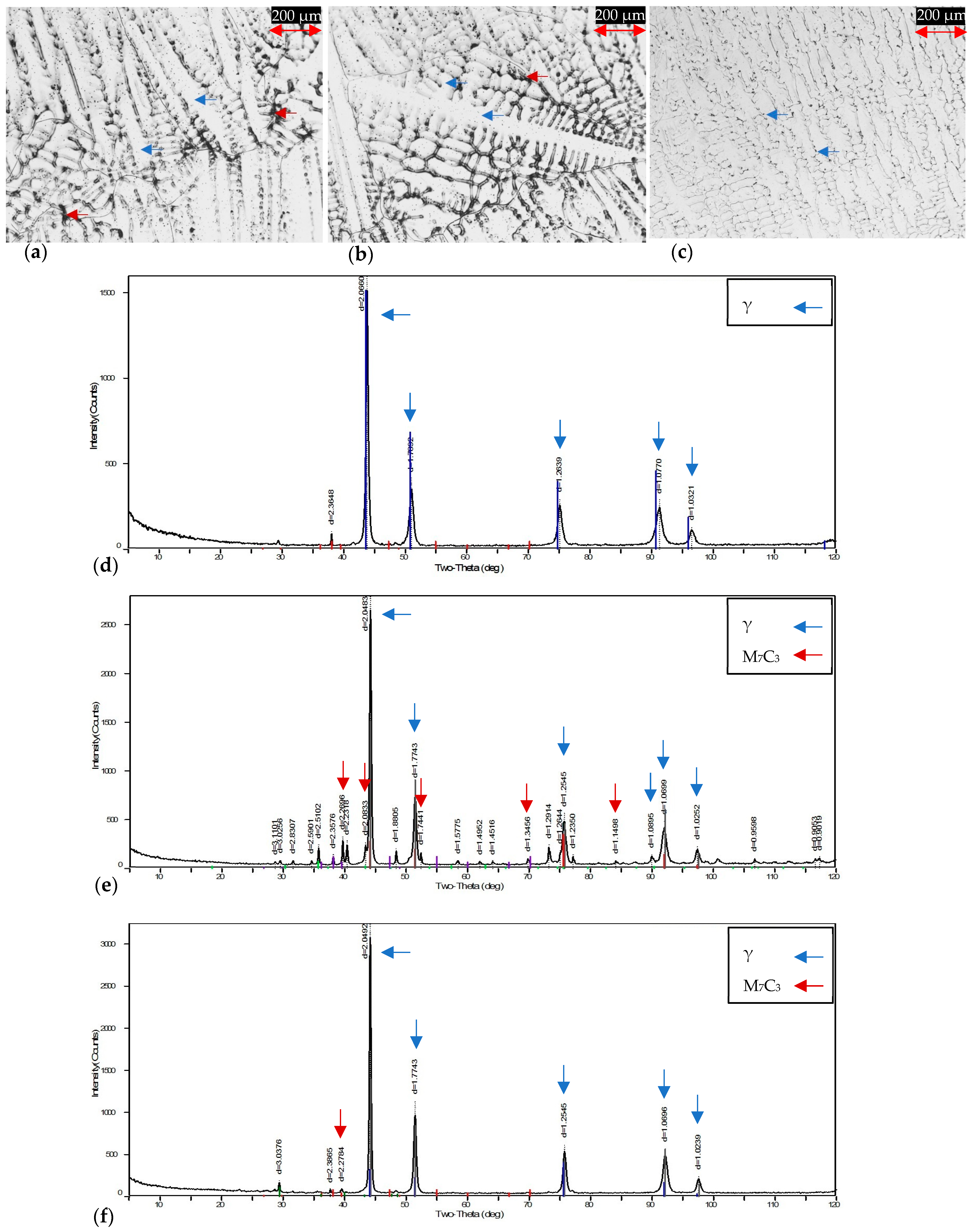

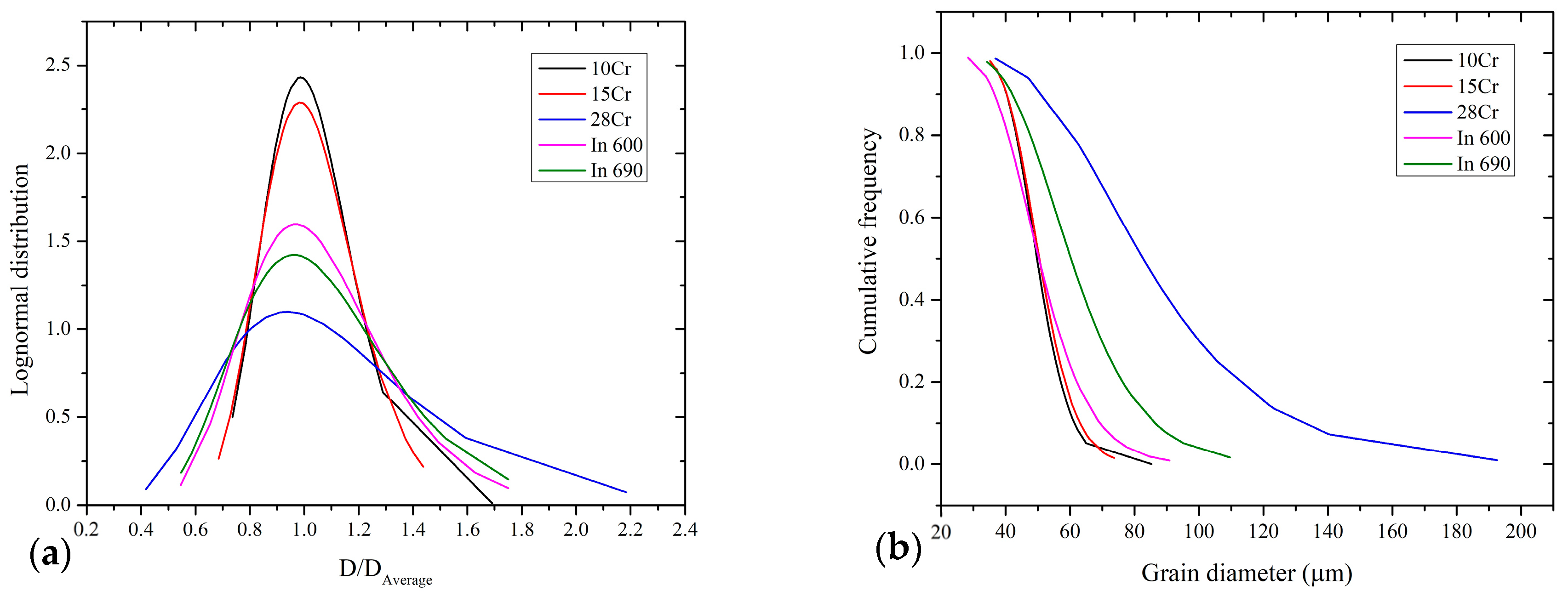
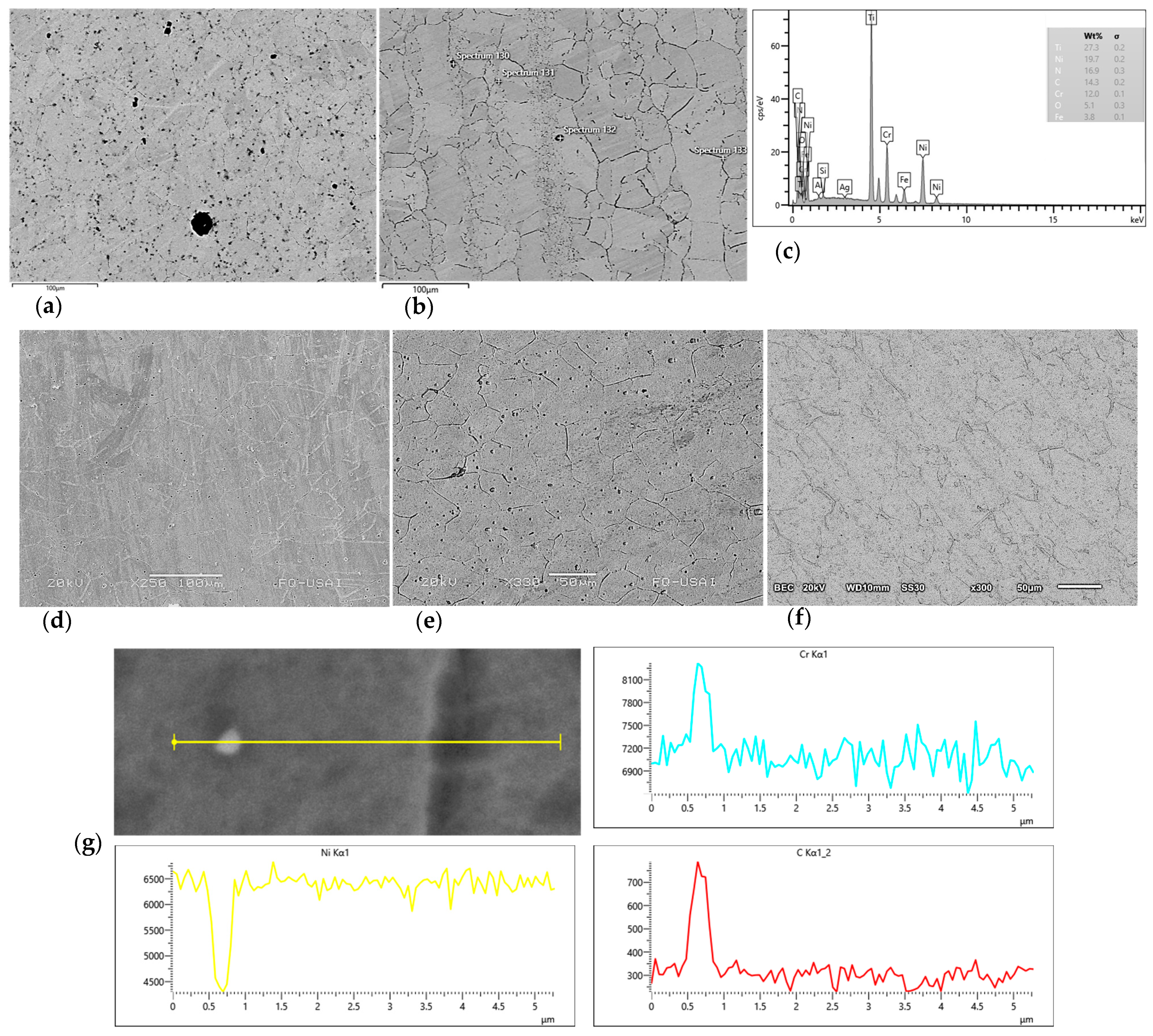
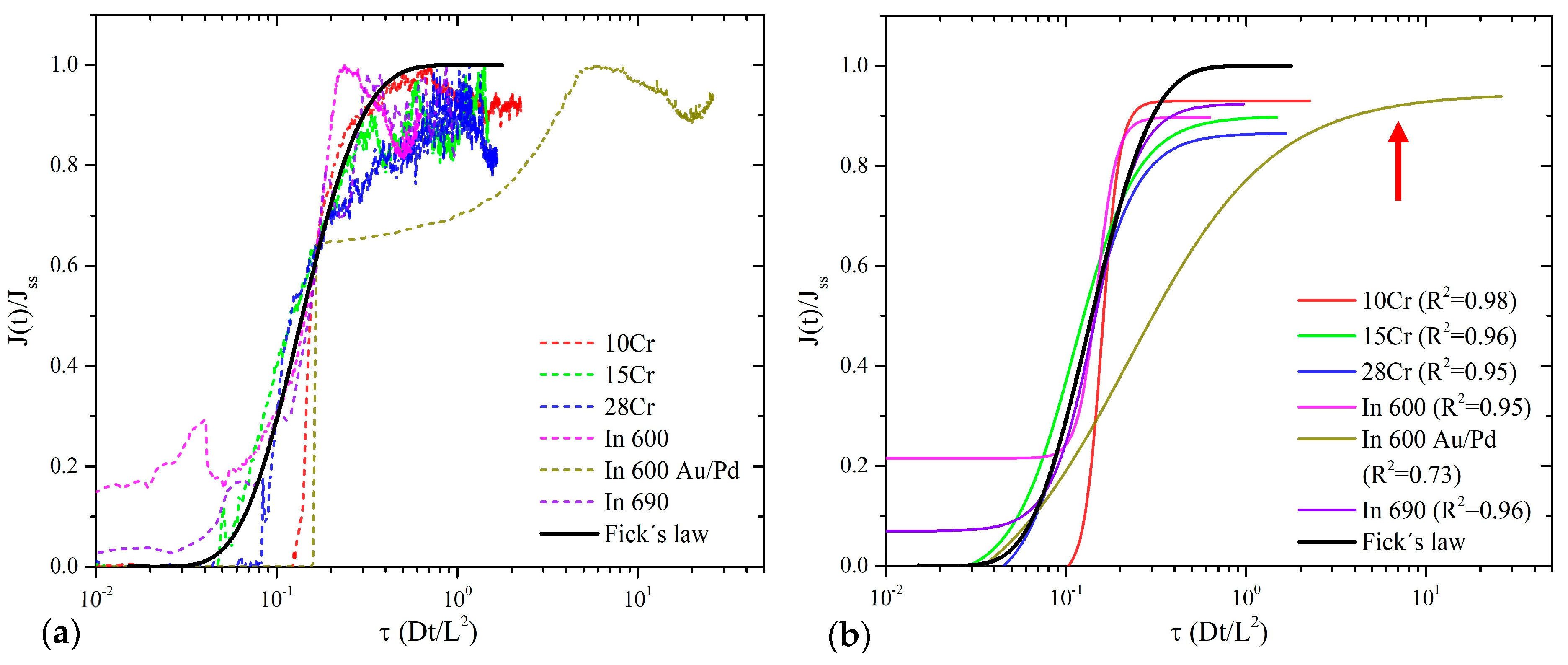
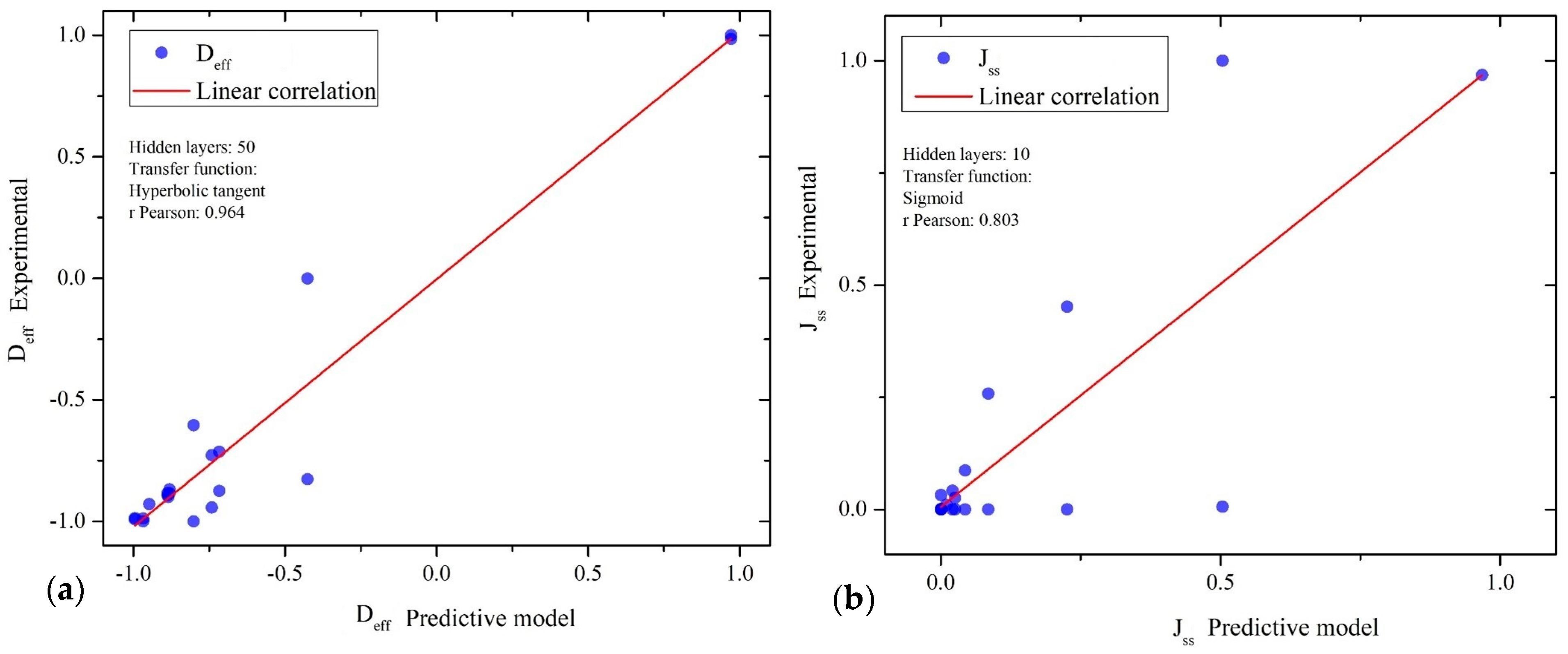
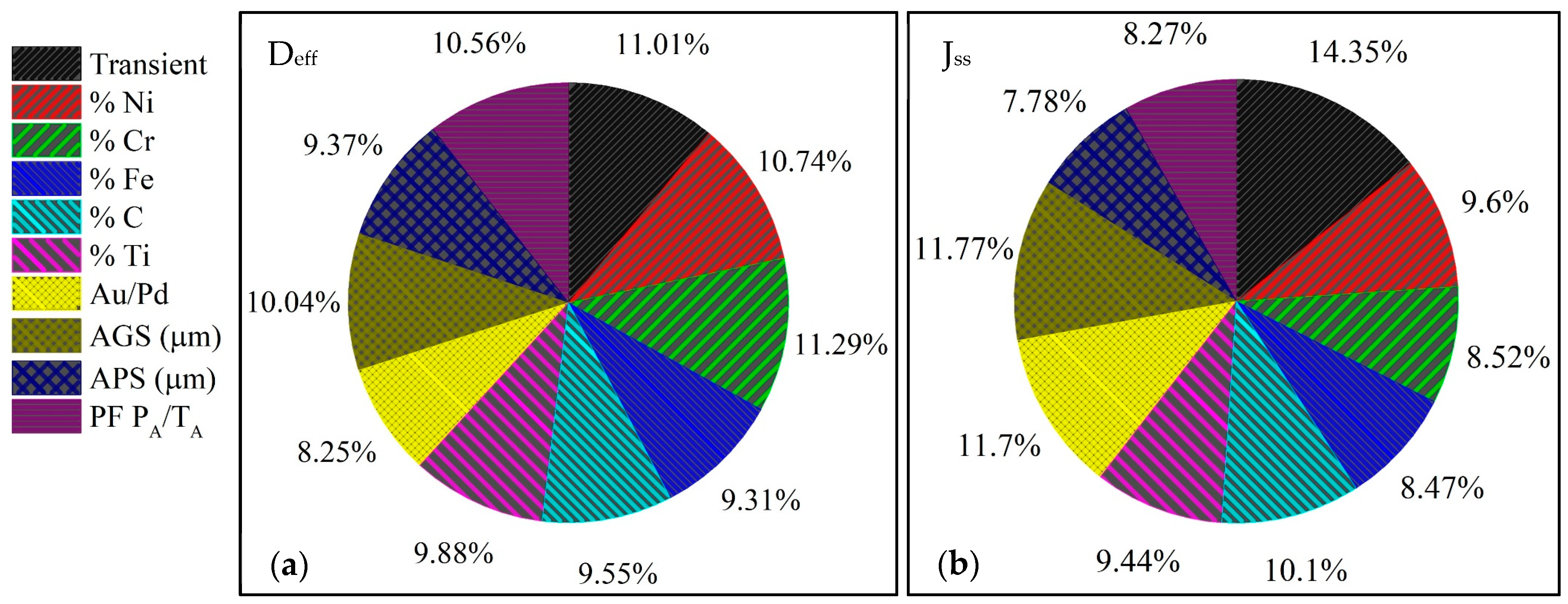
| Alloy | Chemical Content (% wt.) | |||
|---|---|---|---|---|
| Cr | Fe | Ni | C | |
| 28Cr | 28.2 | 9.3 | 62.3 | 0.47 |
| 15Cr | 15.0 | 9.6 | 75.3 | 0.16 |
| 10Cr | 10.2 | 9.3 | 80.4 | 0.155 |
| In 690 | 27.5 | 9.2 | 61.6 | 0.235 |
| In 600 | 15.7 | 6.9 | 77.0 | 0.325 |
| Inputs | Outputs |
|---|---|
| # Number of transient | |
| Ni % wt | |
| Cr % wt | |
| Fe % wt | |
| C % wt | Deff (m2/s) |
| Ti % wt | Jss (mol/cm2s) |
| Coating Au/Pd | |
| AGS (µm) | |
| APS (µm) | |
| PF (PA/TA) |
| Interplanar Spacing, d(Å) | ||||||
|---|---|---|---|---|---|---|
| (h k l) | 2-Theta | 10Cr | 2-Theta | 15Cr | 2-Theta | 28Cr |
| (1 1 1) | 44.16 | 2.049 | 44.18 | 2.048 | 43.78 | 2.063 |
| (2 0 0) | 51.46 | 1.774 | 51.46 | 1.774 | 51.00 | 1.787 |
| (2 2 0) | 75.761 | 1.254 | 75.76 | 1.254 | 75.10 | 1.262 |
| (3 1 1) | 92.14 | 1.069 | 92.10 | 1.069 | 91.32 | 1.077 |
| Lattice parameter, a(Å) | ||||||
| (1 1 1) | 3.549 | 3.547 | 3.573 | |||
| (2 0 0) | 3.548 | 3.548 | 3.575 | |||
| (2 2 0) | 3.548 | 3.548 | 3.571 | |||
| (3 1 1) | 3.547 | 3.548 | 3.574 | |||
| Alloy | Microstructural Characteristic | ||
|---|---|---|---|
| AGD (µm) | APS (µm) | PF PA/TA | |
| In 690 | 62.6 ± 17.4 | 8.0 ± 1.6 | 1.2 × 10−3 |
| In 600 | 51.9 ± 13.3 | 9.5 ± 2.1 | 1.7 × 10−3 |
| 28Cr | 88.1 ± 33.1 | 7.2 ± 1.3 | 4.9 × 10−4 |
| 15Cr | 51.2 ± 9.1 | 5.1 ± 1.0 | 2.4 × 10−4 |
| 10Cr | 50.4 ± 8.8 | 6.1 ± 1.4 | 3.6 × 10−4 |
| Effective Diffusion Coefficient (Deff, m2/s) | ||||||
|---|---|---|---|---|---|---|
| First Transient | 10Cr | 15Cr | 28Cr | In 600 | In 600 (Au/Pd) | In 690 |
| tlag | 1.389 × 10−8 | 7.645 × 10−10 | 2.013 × 10−9 | 1.348 × 10−11 | 7.143 × 10−10 | 2.778 × 10−9 |
| Fourier | 1.442 × 10−8 | 7.848 × 10−10 | 2.075 × 10−9 | 1.382 × 10−11 | 7.470 × 10−10 | 2.791 × 10−9 |
| LaPlace | 1.435 × 10−8 | 7.815 × 10−10 | 2.066 × 10−9 | 1.376 × 10−11 | 7.440 × 10−10 | 2.779 × 10−9 |
| Second transient | 10Cr | 15Cr | 28Cr | In 600 | In 600 (Au/Pd) | In 690 |
| tlag | 1.225 × 10−9 | 1.913 × 10−9 | 9.311 × 10−10 | 3.087 × 10−10 | ||
| Fourier | 1.268 × 10−9 | 1.970 × 10−9 | 9.548 × 10−10 | 3.019 × 10−10 | ||
| LaPlace | 1.262 × 10−9 | 1.962 × 10−9 | 9.508 × 10−10 | 3.005 × 10−10 | ||
| Steady-state flux (Jss, mol/cm2s) | ||||||
| First transient | 1.09 × 10−6 | 2.04 × 10−7 | 2.12 × 10−7 | 1.93 × 10−5 | 3.19 × 10−5 | 9.77 × 10−7 |
| Second transient | 6.36 × 10−7 | 1.35 × 10−7 | 1.40 × 10−7 | --- | --- | 9.97 × 10−7 |
| Hydrogen Trap Density (Traps/m3) | |||
|---|---|---|---|
| Deff utilized from the tlag method | 10Cr | In 600 | Average (all alloys) |
| 7.1 × 1025 | 7.15 × 1025 | 7.1 × 1025 | |
| Linear Correlation, r Pearson | Neurons in Hidden Layer | |||
|---|---|---|---|---|
| Deff (m2/s) | Jss (mol/cm2s) | |||
| Sigmoid | Hyperbolic | Sigmoid | Hyperbolic | |
| 0.96 | 0.95 | 0.80 | 0.79 | 10 |
| 0.96 | 0.95 | 0.79 | 0.73 | 20 |
| 0.96 | 0.94 | 0.79 | 0.80 | 30 |
| 0.95 | 0.95 | 0.67 | 0.77 | 40 |
| 0.94 | 0.96 | 0.74 | 0.79 | 50 |
| 0.96 | 0.94 | 0.79 | 0.79 | 60 |
| 0.96 | 0.96 | 0.73 | 0.80 | 70 |
| 0.96 | 0.96 | 0.79 | 0.80 | 80 |
| 0.83 | 0.95 | 0.80 | 0.78 | 90 |
| 0.87 | 0.94 | 0.72 | 0.79 | 100 |
Disclaimer/Publisher’s Note: The statements, opinions and data contained in all publications are solely those of the individual author(s) and contributor(s) and not of MDPI and/or the editor(s). MDPI and/or the editor(s) disclaim responsibility for any injury to people or property resulting from any ideas, methods, instructions or products referred to in the content. |
© 2023 by the authors. Licensee MDPI, Basel, Switzerland. This article is an open access article distributed under the terms and conditions of the Creative Commons Attribution (CC BY) license (https://creativecommons.org/licenses/by/4.0/).
Share and Cite
Román-Sedano, A.M.; Campillo, B.; Villalobos, J.C.; Castillo, F.; Flores, O. Hydrogen Diffusion in Nickel Superalloys: Electrochemical Permeation Study and Computational AI Predictive Modeling. Materials 2023, 16, 6622. https://doi.org/10.3390/ma16206622
Román-Sedano AM, Campillo B, Villalobos JC, Castillo F, Flores O. Hydrogen Diffusion in Nickel Superalloys: Electrochemical Permeation Study and Computational AI Predictive Modeling. Materials. 2023; 16(20):6622. https://doi.org/10.3390/ma16206622
Chicago/Turabian StyleRomán-Sedano, Alfonso Monzamodeth, Bernardo Campillo, Julio C. Villalobos, Fermín Castillo, and Osvaldo Flores. 2023. "Hydrogen Diffusion in Nickel Superalloys: Electrochemical Permeation Study and Computational AI Predictive Modeling" Materials 16, no. 20: 6622. https://doi.org/10.3390/ma16206622





